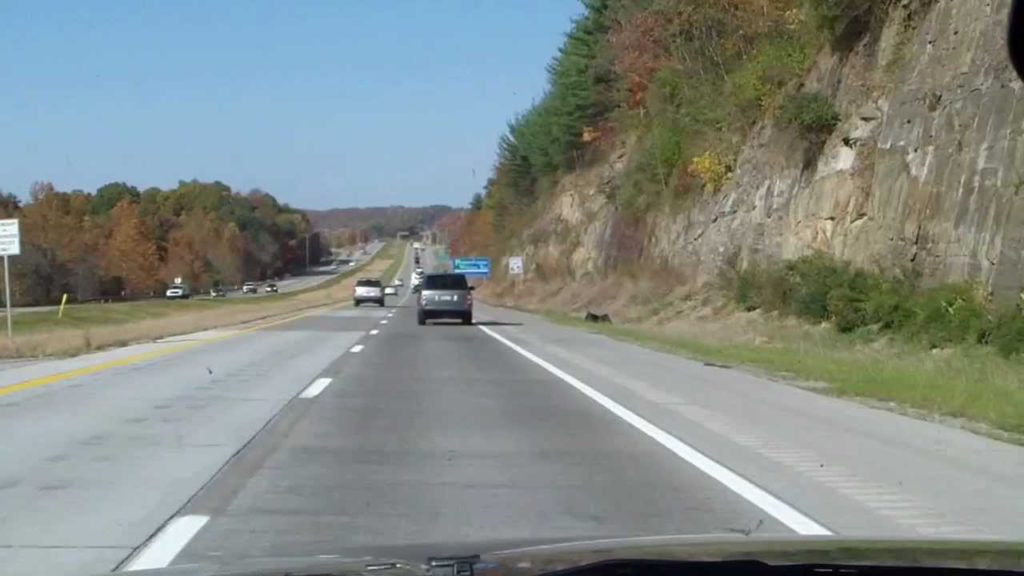
I-79 near the West Virginia – Pennsylvania border
Steve Duffer III died on I-79 in West Virginia, just north of Meadowdale. A homemade memorial dedicated to his memory is perched on the hill beside the highway. It’s legible even from a passing trucker’s vantage point.
Each time I drive by the memorial, I quickly read the name and return my eyes to the road. For some reason I can’t recall much else about the memorial besides the dedication. I think it’s a white wooden cross that’s been hammered into the ground.
Research on Mr. Duffer’s death reveals a tragedy. He died in February 2007 when his southbound red Nissan Frontier pickup crossed the meridian on Jennings Randolph Expressway (what I-79 is named in West Virginia) and hit a tractor trailer.
The 2001 Mack tractor trailer in the northbound lanes was running out of Hickory, North Carolina – where I have picked up and delivered numerous times in my nine months as a truck driver.
Duffer was from Pursgolve, a bit further up I-79 and just past Morgantown, home to West Virginia University. I’ve come to know this highway well. It’s the route I take going to and coming from the Carolinas.
Duffer’s memorial catches my eye because it’s placed at truckers’ eye level. On the other hand, much of what I see on the side of the road is lower down – namely deer.
The Deer
Deer typically graze in grassy areas alongside the highway. That’s the way I like to see them: serenely alive and eating contently. Sadly, that’s not the reality. Most of the ones in view are lying at the side of the highway in varying states of mutilation and decomposition. There’s no other way to put it.
When you see enough of them, you become immune to the fact that deer see headlights at night and evidently don’t pause to consider a potentially brutal end. They are a constant reminder of one of the chief rules of highway truck driving: you can’t ever swerve to elude an animal that’s suddenly crossed your path. The attempt can result in far worse fates than the death of a beautiful creature – namely your death or the death of innocent other drivers.
As sad as it is to see so many dead deer – at least one every 15 minutes – it’s also a poignant reminder of how I need to drive on the incredibly busy US highway system: carefully. Many stretches are endlessly busy, especially in the summer and during rush hours. Those are times to focus even more on the road and understand that if something doesn’t involve safe navigation of your truck and trailer, don’t look at it.
‘Gators’
Then there are the gators. No, there are no actual alligators on the highways. When a truck tire blows out, it comes off in strips and pieces and those strips and pieces get scattered on the highway. They have come to be known as gators because they can look like an alligator’s back. They’re often long and heavy and can cause accidents.
As the article says, gators “can surpass that of its namesake, slicing open oil pans, ripping off steering components, smashing through windshields and causing panicked drivers to swerve themselves into a crash, attempting to avoid the beasts.”
Other Stuff I See
Many Canadian drivers I’ve talked to notice the amount of garbage scattered about on U.S. highways. There’s a lot of it, much more than you’ll typically see here in the North. I guess it’s because there are a lot more people living in the U.S. and a lot more drivers using the highways. Evidently, many of these drivers simply toss trash overboard.
Sometimes this trash is cleaned up by work crews. More specifically, it’s picked up by crews of prisoners in orange jumpsuits who walk about and gather the refuse with the use of a long-handled trash picker.
Other crews of non-prisoners cut the grass alongside the highway and at roadside rest areas. There are always signs signalling their presence. Similarly, there’s always plenty of advance notice signaling the presence of construction crews. And there’s always construction underway somewhere.
Roadside rest areas are a trucker’s best friend in times of need, be it a washroom break, a short period of rest or getting something to eat from the truck’s fridge. I wish there were a lot more rest areas but the dozens that I’ve visited are almost universally clean and well-maintained. Some are even beautiful and marked with memorials: to soldiers or miners for instance. I’ve had some good sleeps at these stops.
Then there’s the scenery, and I’m not talking about the thousands of houses, restaurants, hotels, motels, service stations, truck stops, warehouses, stores and shopping complexes that line both sides of the freeway in West Virginia towns like Sutton and Summersville and Virginia towns such as Beckley and Wytheville.
I’m talking about the views: the rolling hills of Pennsylvania that run into West Virginia, where they morph into lush green mountains with stunning valleys in between. That continues all the way into the Carolinas, especially on the western side.
And, of course I’m talking about the beautiful deer. Long may they live. I love to see them.
